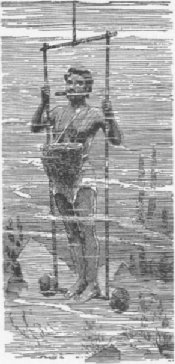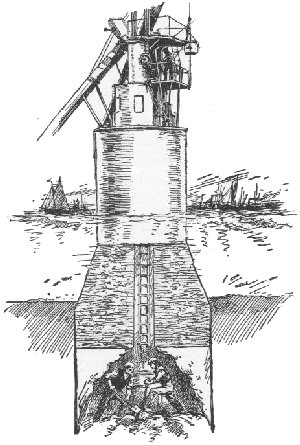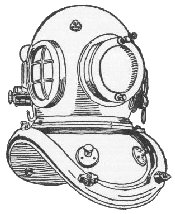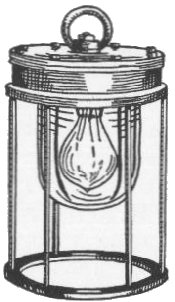DIVING SUITS AND DIVING BELLS
Diving for Pearls—The Inventions of Siebe and Fleuss—Pino’s Hydroscope and Elevator—What Divers do.
ONE hears a good deal about the high cost of clothing to-day, yet the ordinary citizen gets off cheaply when compared with the diver. His is the heaviest suit that any man ever wears; the leadensoled shoes alone weigh forty pounds, while two sixteen-pound weights are hung round the diver’s neck, and when arrayed ready for descent he is wearing in all something like one hundred and sixty pounds weight of equipment.
But we are getting on too rapidly, so for the moment let us turn to the beginnings of under-sea work. Diving is one of the world’s oldest industries, for pearls have been treasured as far back as history extends. But for thousands of years the treasures of the deep were obtained without the aid of diving bells or diving suits, and even to-day men still dive to depths as great as ten fathoms without artificial aid except a big stone and a rope. Some of these men can stay down as long as four minutes, but it is killing work, and not many can stand more than a few years of it.
The invention of the first diving apparatus is generally ascribed to that wonderful old monk, Roger Bacon; but this is mere tradition, and the first reliable account of a diving bell refers to the Aquatic Kettle used by two Greeks before the Emperor Charles V at Toledo in Spain. This evidently resembled the modern diving bell, except that it was not fitted with means for replenishing the air supply, and therefore its occupants could only remain down for a very short space of time; when the air had become too foul to breathe they had to signal to be pulled up again.
The first attempt to give the divers a constant
 |
A little later John Lethbridge constructed a real diving bell—the first to be made in bell shape. This, before sinking, was filled with compressed air by means of a large
bellows, and two men could work in it for half an hour. Many attempts were made during the eighteenth century to improve the diving bell, and one or two inventors tried to build diving suits. But, since rubber was still unknown, they were forced to use leather instead, and of this material it is impossible to form a satisfactory diving suit.
The air pipes, too, had to be made of leather—a purpose for which this material was equally unsuited.
Smeaton, one of the greatest engineers of the eighteenth
 |
century, was perhaps the first to make a diving bell which was constantly supplied with air by means of a pump. It is known that he used such an invention in 1779 for repairing the foundations of a bridge in Northumberland. Nine years later he was busied in constructing the harbor of refuge at Ramsgate, and here he built a diving bell of solid iron weighing two and a half tons, which sank by its own weight. In 1813 Rennie used a still larger bell, five tons in weight, of similar construction. Air was supplied by a pump through a two-and-a-half-inch hose, and was admitted into the bell through a valve; this was really the first of modern diving bells. Throughout the nineteenth century various designers built bells of ever-increasing size, until the one constructed for fixing the huge blocks used in the foundation of the breakwater of North Wall Harbor at Dublin was no less than twenty feet square, its weight being over eighty tons. The workmen entered by means of a wrought-iron shaft and air lock, so it was really more of a caisson1 than a mere diving bell. Our sketch shows one of the caissons used in 1925 in the construction of a temporary bridge during the rebuilding of Waterloo Bridge, London.
The diving bell is still used for certain kinds of work, and more particularly when two or three men have to work together under water; but it is at best a somewhat clumsy contrivance, and now that the diving suit has reached such perfection the bell has been largely superseded.
The modern diving suit depends for its usefulness on the helmet, which was invented by Augustus Siebe in the year 1829. As first made, the helmet was nothing more than a miniature diving bell which covered the diver’s head. The canvas jacket, which was fastened to the helmet, was left open at the bottom, and the air pumped down into the helmet for the diver’s use escaped under the weighted edges of the jacket. The result was that at all times the water was only a few inches below the mouth of the unhappy diver, and he dared not stoop. It was another ten years before Siebe got rid of the dangers attending the use of this suit by inventing the closed suit as at present worn.
It will perhaps be interesting to describe how a diver dons his armorlike costume before descending into the depths of the sea. First, then, he takes off his coat, hat, and boots. He next puts on, one after another, three pairs of immense woolen stockings. Over his head he draws two heavy white guernseys, and he wears also two pairs of thick drawers, both made of the warmest wool. However hot it may be on the surface, the depths are always cold. Snugly buttoned up in his thick woolen undergarments, the diver is then ready to get into the diving suit—an uncanny-looking affair, which is body, legs, and feet in one piece, and which has the singular merit of fitting equally well a big man or a little one.
It is made of solid sheet India rubber placed between specially prepared double-tanned twill, and is fitted with India rubber cuffs which are so made that they form an absolutely water-tight joint at the wrists. The wearer’s hands and wrists must be well soaped before he puts his hands through the sleeves. The collar is made double. The inner part of waterproof twill is fastened round the neck, while the outer, of thick rubber, has screw holes, matching similar holes in the breastplate to which it is fitted.
The breastplate is made to fit over the shoulders, but is large enough to allow plenty of room for a free movement of the diver’s arms; it is clamped to the rubber top of the dress so as to be absolutely water-tight, and is fitted with brass knobs over which cords pass from two hooks, one on each side of the helmet, for slinging the two leaden weights already mentioned. After the breastplate is fitted, the diver puts on his boots, which are made of leather, gun metal, wood, and lead. Each weighs sixteen pounds, and is of enormous size.
Now at last the diver is ready for his helmet, which is by far the most wonderful part of the whole kit. Like the breastplate, it is made of copper with gun-metal fittings which connect so cleverly with the breastplate that only one-eighth of a turn is required to make the joint absolutely water-tight. To admit light, the helmet is fitted in the sides with two oval windows of thick plate glass, set into brass frames. There is another glass in front, also set in a brass frame, which
 |
The air pipes used with a diving suit are tested up to a pressure of no less than two hundred pounds to the square inch, and accidents from the failure of diving apparatus made by well-known firms are almost unknown. The most modern suits are fitted with telephones, so that the diver can at any moment communicate with those above. Previously he had to rely entirely upon signals made by pulls upon the life line.
One of the most useful inventions for under-water work is the diving suit invented in 1880 by Mr. Fleuss, which makes its wearer independent of air supplied from above. In a strong copper cylinder fixed upon his back the diver carries a supply of compressed oxygen regulated at will by a screw valve. The carbonic acid exhaled by the wearer is absorbed by caustic soda contained in a separate receptacle, while the nitrogen of the air mixes afresh with the oxygen and can be breathed over and over again.
In this suit, which weighs less than thirty pounds, the diver can remain below water for at least two hours, and the invention is invaluable for all who have to work in flooded mines or in any place where there is danger of the air pipes being entangled among timbers or other debris.
One of the latest devices to aid the diver is an outfit, very like a sack with a special battery attached, invented by Dr. Draegs for restoring a diver who has become unconscious or has fallen victim to the pressure sickness to which divers who work at great depths are liable.
The diver naturally finds it difficult to see under water, especially in northern seas, where the water is usually so thick that, even at a very moderate depth, the darkness is almost complete. The modern diver is well provided for. He has at his command powerful electric lights supplied with current from the boat above. When working in enclosed spaces he uses an electric lantern provided with an accumulator.
Early in 1924 a young Italian inventor, Professor Leandro Guglielmotti, patented a new invention which, if it justifies the claims made for it, will be a most valuable aid in all sorts of submarine work. It is a process by which the law of refraction is overcome and which
 |
Guglielmotti’s new invention, it appears, projects through the water shafts of invisible light which will illuminate any body coming in the direction of their rays up to a distance of three hundred yards and to a depth of about fifty feet.
Another Italian whose under-water inventions have brought him fame is Cavaliere Pino, the deviser of the hydroscope. Pino, born at Chiampo in Venetia, was left an orphan at an early age, and from boyhood devoted his spare time to devising new inventions. Finding that his relatives looked upon him as a lunatic, he ran away from home and went to Genoa, where he got work in the Royal Bread Factory. One day the manager of the bakery found the boy busy during his dinner hour with pencil and paper, and asked him what he was drawing. Young Pino explained that he was designing a new sort of submarine boat, and so interested the manager that the latter gave him an introduction to a firm of engineers, and himself advanced money to help build the new craft.
Pino was only twenty-four years old when the plans for his new submarine were complete. The one point on which he was uncertain was the breathing apparatus he had designed, so, in order to test it, he had a metal box made, and in this, after it had been hermetically sealed, he had himself lowered to the bottom of the Gulf of Genoa. In case of danger he could make a signal, when his friends were to pull his metal coffin to the surface.
Minutes dragged by, but no signal came, and at last the watchers could bear the suspense no longer and hauled up. When they opened the lid, there was Pino, very much alive, but very angry. "I gave no signal," he exclaimed. "Why could you not have left me? I was just beginning to enjoy myself." In Pino’s submarine it is said that a man can descend to a depth of five hundred feet, or more than twice the depth which can be reached in the ordinary diving suit.
Pino’s hydroscope consists of a long tube fitted with various lenses so arranged that objects lying at the bottom can be reflected upon a screen on the deck of the ship that carries it. Pino has also devised a machine called an "elevator", by means of which sunken objects can be grappled and raised to the surface. Since it is calculated that the average monthly loss of vessels sunk in all the seas exceeds fifty thousand tons, the value of these inventions should be enormous.
The large number of ships sunk during the Great War has led to a great increase in diving all over the world. A diver receives, besides his wages, a commission upon the objects which he salvages, so that some earn considerable sums. But he must start young and be thoroughly sound in wind and limb. A man with weak heart or nerves is useless as a diver.
Apart from ship salvage, divers find employment in pearl fishing and in gathering sponges. Since all the shallower beds of pearl oysters have been skinned long ago, most of the work at present is done in diving suits, and at depths varying from sixty to a hundred and ten feet. While a diver can remain at a depth of forty or fifty feet for two hours on end without inconvenience, he cannot endure depths of over a hundred feet for more than about twenty minutes at a time. Under high pressure the blood absorbs air quickly, and air bubbles may pass into the heart, which causes death. A diver who has been at a depth of, say, a hundred and fifty feet for twenty minutes must come up very slowly, taking fully twenty minutes in his ascent. Otherwise he will probably contract diver’s palsy and die.
Pino’s submarine is not the only device enabling the diver to work at depths beyond what is possible with the ordinary diving suit. Another more recent equipment gives the impression of a castle tower. Entrenched within its walls the diver can defy the air pressure of five hundred feet and more. He is lowered and raised again by means of a derrick or crane.
Divers are constantly at work building or repairing harbor works or breakwaters, and every large dock has its own divers. One of the strangest tasks ever performed with the aid of a diving suit was the saving of Winchester Cathedral. Eight centuries ago the eastern arm of this cathedral was built upon foundations made of trunks of trees laid in the soft soil. These gradually sank under the immense weight of masonry, and it was found necessary to underpin the building with blocks of concrete. The whole of this work had to be done under water, and nearly all of it was done by one man, Mr. W. R. Walker. For four and a half years he was constantly busy burrowing under the cathedral, and the whole time working in pitch darkness, for the water, black with peat, was too dark to allow the use of electric light.
1 A large water-tight case used in laying foundations under water.
Return to text
Chapter 14
Chapter 12
Table of Contents
Return to Main Page
© 2000, 2001, 2002 by Lynn Waterman